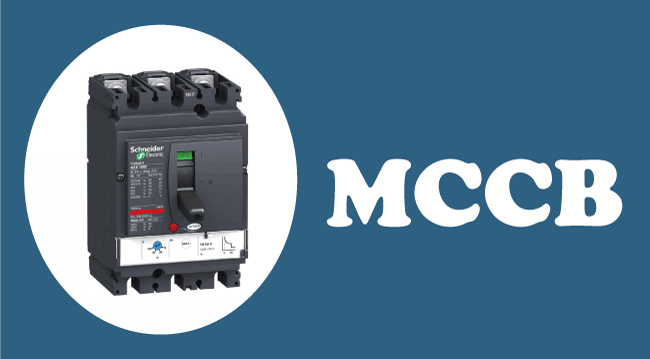What is the full form of MCCBMCCB: Moulded Case Circuit BreakerMCCB stands for Moulded Case Circuit Breaker. The need for power is rising in today's world. We not only appreciate the worth of electricity when it is scarce, but we also need to ensure that there are clever ways to conserve it. Electricity devices are being deployed to monitor the current flow to address this problem. Short circuits and current overflows can occasionally result in circuit damage. So, in such scenarios, the circuits are protected by low-voltage switchgear. Read on to know what is MCCB, its specifications, components, and functions. 
What is MCCB?Moulded Case Circuit Breaker is known as MCCB. When a microcircuit breaker's maximum allowable load current is exceeded, this additional form of electrical protection mechanism is used. The MCCB switches the circuits and offers protection against overload and short-circuit failures. Even domestic applications can be utilized for higher current ratings and fault levels. Industrial applications use the MCCB's broad current ratings and high breaking capacity. MCCBs can be used for main electric feeder distribution, generator protection, and capacitor bank protection. It provides suitable protection when an application calls for discrimination, configurable overload settings, or earth fault protection. Miniature Circuit Breakers are called MCBs, whereas Moulded Case Circuit Breakers are called MCCBs. Knowing the differences between MCB & MCCB can help you understand their features and applications. Difference Between MCB and MCCB?Due to their capacities, MCB and MCCB differ significantly from one another.
With the aid of electrical motor operators, these are developed to adapt to remote control signals and are employed as standby power in businesses and industries. Features Of MCCB
The MCCBs, which can be manually or automatically disconnected, are frequently used in PV systems in place of MCBs (miniature circuit breakers). MCCBs are kept in a moulded box to shield them from chemicals, rain, dust, and other elements. These devices' large currents occasionally require adequate maintenance, which may be accomplished by routinely washing, lubricating, and testing. Keep your electrical equipment safeFor improved performance, a constant current flow is required by all of your electrical equipment. Installing an MCCB or MCB is crucial, depending on the load current. By doing this, the power supply can be isolated during an electrical fault, protecting the sensitive machine control systems. Avoid FiresTo provide the highest level of safety, MCCBs that adhere to industry requirements and have good quality are advised. These electromagnetic devices protect electronic equipment from fire, heat, & explosion by detecting faults during electrical surges or short circuits. MCCB Components and SpecificationsThe following are the MCCB's four main parts:
FrameIt also goes by the name "moulded case" and offers room for an insulated housing to attach every component of the circuit breaker. This is built of thermoset resin composites or glass polyester to give excellent electrical properties within its compact package. The designation is given based on the type and size of the moulded case, and it is also used to characterize the breaker's properties (maximum voltage & current ratings). Operating SystemThe working mechanism is used to open and close the connections. The pace at which the handle is pushed affects how quickly the contacts open and close. You can see the grip halfway if the contacts are tripped. When the breaker is turned on, it cannot trip; this is known as being "trip-free." If the handle is in the middle when the breaker trips, it must first be moved to the off position before being transferred to the on position. The various handle positions are helpful when there are several breakers installed together, such as on panel boards, to identify the faulty circuit. There aren't many breakers with a manual trip to check the mechanism. Extinguishing ArcsExtinguisher for arcs: An arc is produced when a circuit breaker stops current flow. An arc extinguisher's job is to contain and divide the arc, which extinguishes it. The high-strength insulating box that surrounds the arc extinguishing chamber is mostly made of a stack of steel plates. The current traveling through the ionized portion of the contacts creates a magnetic field surrounding the arc, and the arc extinguishes when the contacts split due to an interruption. The arc is driven into the steel plates by the magnetic field lines formed around it. The arc then divides, enabling the gas to cool. The gas is subsequently deionized. A linear current flow operates the contacts of a standard MCCB, and in the event of a short circuit, a tiny blow-apart force has produced those aids in opening the contacts. Travel UnitThe trip unit is the circuit breaker's brain. In the event of a short circuit or a persistent overload current, the primary purpose of a tripping unit is to trip the operating mechanism. The trip units in conventional molded case circuit breakers are electromechanical. Combining a temperature-sensitive electromagnetic device with a current-sensitive electromagnetic device, both of which work mechanically on the trip mechanism, protects protection for a circuit breaker. MCCB ApplicationsMCCBs are commonly used in heavy-duty applications such as variable trip settings for applications where low currents, guarding motors, protecting capacitor banks, protecting welding machines, protecting generators, and protecting electric feeders since they are made to handle large currents.
Next TopicFull Form
|
 For Videos Join Our Youtube Channel: Join Now
For Videos Join Our Youtube Channel: Join Now
Feedback
- Send your Feedback to [email protected]
Help Others, Please Share










